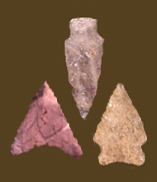
|
KANAWHA STEMMED
Chronology The Kanawha Stemmed point dates to the Early Archaic period, although some archaeologists, following Gardner (1989), see the introduction of bifurcate base points as the beginning of the Middle Archaic. Broyles (1971) obtained a radiocarbon date of 6210 +/- 100 BC (approximately 7100 BC in calendar years) for the Kanawha at the St. Albans site in West Virginia. Chapman (1976) suggests a date range of 8200 to 7800 BP (roughly 7200-6650 BC) based on its stratigraphic position between LeCroy and Stanly points at sites in Tennessee. Steponaitis (1980) suggests a range of 8300 to 8000 BP (7350 BC-6900 BC). Some bifurcate base points have been found in contexts dating between 7000 and 8000 BP in the Northeast, with the youngest radiocarbon dated to 5185 +/- 200 BC (approximately 6025 BC calendar). This may suggest that some bifurcates, as well as other Early Archaic points like the Kirk, continued in use in the North long after disappearing from the Southeast (Funk 1993; Kent 1996). Description Blade: The blade is triangular and usually narrow. Edges are straight, incurvate, or recurved, and are usually serrated. Re-sharpening is common, often resulting in flared shoulders and blade asymmetry. Haft Element: The base is generally, but not always, bifurcated and thinned, with no evidence of grinding. The basal notches tend to be shallower than on most other bifurcate types. Flat or slightly concave bases do sometimes occur. The stem is expanded and has rounded corners, and is up to one half the width of the blade. Shoulders are wide and straight; most are at right angles to the stem, but some slope up toward the tip. Size: Length ranges from 19 to 48 mm, with most between 30 and 36 mm. Width ranges from 19 to 37 mm, with most between 23 and 27 mm. Thickness ranges from 3 to 7 mm. Technique of manufacture: Made by percussion and pressure flaking. Material: In a sample of 16 Kanawha points from the lower Patuxent drainage, Steponaitis (1980) reported that 31% were quartz and 31% rhyolite, followed by chert and quartzite at 19% each. In the area surrounding Zekiah Swamp on the lower Potomac, Wanser (1982) found that 51% of 37 Kanawha points were rhyolite, with 38% quartz, 8% chert, and 3% quartzite. Of the 9 Kanawha points found at the Indian Creek V site in Prince Georges County, 6 were rhyolite and 3 quartz (LeeDecker and Koldehoff 1991). In the Monocacy River drainage, 70% of 20 Kanawhas were rhyolite, while the rest were quartz (Kavanagh 1982). Chert Kanawha points predominate in the middle Potomac River Valley, but rhyolite and quartzite are also used (Hranicky 2002). In Delaware, bifurcate base points are commonly made from chert, jasper, and rhyolite (Custer 1996a). Discussion Defined in Literature The Kanawha point was originally described by Broyles (1966; 1971) using examples recovered from the St. Albans site in West Virginia. References |
![]()
Search by Shape:
(See Projectile Point Typology) |

|
Thank you for visiting our website. If you have any
questions, comments, Copyright © 2002 by |

|

 Defining Attributes
Defining Attributes